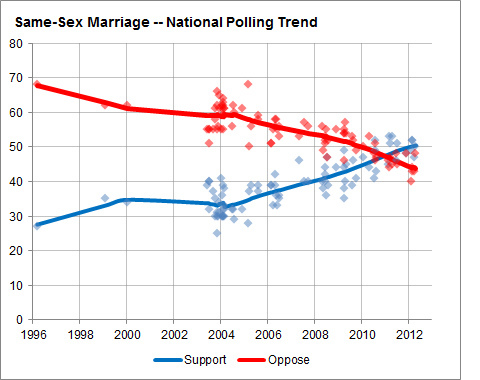
The blue line represents the rate at which various groups adopt the new idea/technology and the yellow line shows its market share.
When it comes to something like GLBT rights, we might think of activists such as Harvey Milk as an innovator. Liberals and/or Democrats were the early adopters who joined the cause - even with a minority of support. As the early majority was building, folks like Karl Rove took advantage and - knowing all he needed was 50%+1 - worked to put things like marriage equality on the ballots in several states in order to drive up Republican turnout. But as we've seen recently, support for marriage equality has passed from being accepted by the early majority into the late majority stage just this year.

I suspect that we could take any number of liberal causes and map through their diffusion processes over time.
What we might learn from this is that most politicians won't act on an issue until it begins to reach the late majority. That is only to be expected in a democracy where, in order to win an election, they need to get 50%+1 of the vote (and of course now that has moved to 60%+1 for legislation with the Republican's addiction to the filibuster).
In order to get to the place where politicians can act, we need activist leaders working to reach the early majority and get them on board. That's why you almost never heard of someone like Martin Luther King, Jr. focusing his efforts on getting politicians to pass civil rights legislation. His activism was all about opening the eyes of the early majority to the devastation of Jim Crow laws. The scales tipped into the late majority (mostly in Northern States) signing on to the message in the early 60's and hence, the passage of the Civil Rights Act in 1964. That never would have happened when they started the Montgomery Bus Boycott in 1955.
For me, this explains a lot about why liberals often feel victimized in the sense that they are right about an issue and yet lose battles politically. Our efforts are better spent in reaching that early majority than they are in pressuring Congress and/or the President. And they are certainly better spent on that task than raging at the laggards who are behaving like a dying cornered beast.
In our polarized political environment, you might wonder where this early and late majority lies. I think it can be found in people like Michael Stafford, who I wrote about earlier this week. They don't get as much air time these days with our conflict-driven media. But they're out there...I would suggest in big numbers.
P.S. If you'd like to learn a little more about how to reach the early majority, take a look at this fascinating TED talk by Simon Sinek.




This is exactly what I've been saying ... and why I maintain that while trying to elect Democrats and all that is fine, if you want real lasting change, work to change the culture. Work in the media, the arts, film, literature, etc. is what changes the culture. A movie like "Philadelphia" did more for the AIDs issue than all of the progressive politicians in office at the time.
ReplyDelete